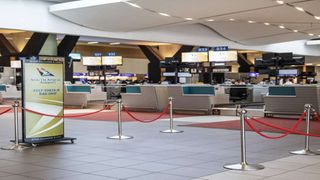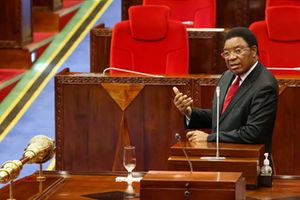
OR Tambo International Airport.
| Courtest | AFPThe African kids who fly 370km to school
The other day on an early evening flight from Johannesburg to the Botswana capital Gaborone, a colleague sat behind me. Next to him was a self-assured lad of 12-14.
They got talking. He asked him how his day was. The little man sighed heavily and said it had been a difficult day at school. My colleague was puzzled. He asked if he was coming from school.
“Oh, I go to school daily in Johannesburg, I am heading back home now”, he replied.
“You go to school from Gaborone to Johannesburg daily?” he asked, astonished.
“Yes.”
So, from Monday to Friday, when in Nairobi and Dar es Salaam kids are dashing at dawn to catch a matatu or school bus, this lad is dropped off at Sir Seretse Khama International Airport, jumps on a flight, crosses an international border, lands in Johannesburg, 370 kilometres away, after a 40-minute flight and on to school in time for the assembly.
He probably arrives before a child being dropped from the far end of Mombasa Road to a school in Lavington gets there on a bad-traffic day. And at the end of the day, he heads to OR Tambo International Airport and does the return leg.
The lad got off the aircraft, walked quickly through immigration and out to a waiting car. It seems he is not the only kid who does that. He must have interesting conversations with his parents.
“Mum, the weather in Johannesburg is bad, our flight is delayed. I might be late for dinner in Gaborone,” he might say.
Part of this is made possible by the rise of a wealthy middle class in African countries like Botswana. The other is regional integration and the common market—in this case, the Southern African Development Community (SADC). Equally important is a broad outlook.
Of course, at Kenya’s border with Uganda at Busia and Malaba, hundreds of children cross on foot in either direction to go to school. However, the border people don’t see the border. And the children go to a school half a kilometre away, not 370km.
Next, the ‘Flying Student’ might go to the prestigious Waterford Kamhlaba United World College of Southern Africa, in Mbabane, Eswatini, and then make his way to Ashesi University, in Accra, Ghana.
Graduate school might beckon at the London School of Economics, where he will meet—and eventually marry—a young woman from Trinidad and Tobago.
That Bostwana chap will be a very different kind of African and global citizen. He will come of age in the kind of Africa President William Ruto probably envisaged when, in late October, he announced that Kenya would soon enable all Africans to visit the country visa-free.
Open attitude
The public response surprised me, who had taken Kenya’s generally open attitude on these issues for granted.
Going by the comments on blogs, social media and opinion articles in the newspapers, the majority were either sceptical or downright opposed to the suggestion.
It wasn’t clear whether the problem was with the message or the messenger. In calmer times, when political temperatures are down, a greater cosmopolitan spirit will return.
The one thing that is not down in the south, especially Botswana, right now is the temperature. It is sweltering hot.
Appropriately, in Dubai, the world has gathered for the 28th UN climate change conference, COP28. One side story that has made headlines is the record number of delegates African governments have sent. According to the UN’s attendance list, Nigeria, Morocco, Kenya, Tanzania, Ghana and Uganda were among the nations with the largest teams. Nigeria was tops, at 1,411.
A cynical African public has dismissed the large delegations as a gravy train. They claim that most of them have gone to Dubai to shop. But I tried to find a positive spin to these stadium-size delegations. It was not easy, though I eventually did.
We shall call him Abdul. Abdul is also a comedian; so you never know when he taking the mickey.
“Come on, come on,” he said, “you know how many delegates are in COP28? Over 110,000? What is a few thousand black faces in the crowd?” He went on: “Africans are going soft. They are forgetting the strategies of war. It’s smart to ‘stare down’ your opponent. You show up in large numbers, and you get into the faces of climate change, and the hypocritical polluting industrialised countries.
“Two hundred Africans can’t intimidate anyone. But 5,000? They can’t ignore you.”
“Surely Abdul, you can’t be serious,” I pushed back.
“I am. It is like the haka that New Zealand’s rugby team, the All Blacks, perform before the start of big games. Serious stomping, tough faces, tongues hanging out, loud beating of chests, screams. A faint-hearted opponent could be frightened. The Africans are doing the haka equivalent at COP28”, he insisted.
Thank God, Abdul is not in charge of leading Africa’s climate fight; that Motswana lad would become a man in a world that is far hotter than it is.
- Mr Onyango-Obbo is a journalist, writer and curator of the "Wall of Great Africans". @cobbo3





